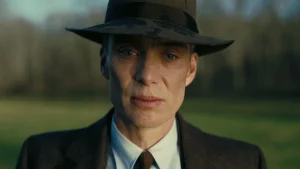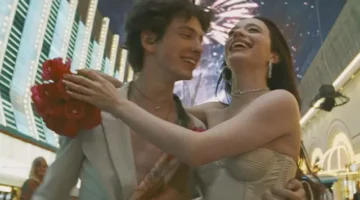Tropic Sprockets / Oppenheimer
By Ian Brockway
 The epic maestro Christopher Nolan (The Dark Knight) scores a hit with “Oppenheimer” the immersive and detailed bio pic about the father of the atomic bomb. [Check Tropiccinema.com for showtimes and trailer.] Comprehensive and thorough, this film is highly engaging and maintains its watchability despite a challenging running time of 180 minutes. The film clearly illustrates the journey of the scientist J. Robert Oppenheimer, highlighting his height of success, as well as his descent into anxiety and despair. This is a cinematic and Taoist portrait of an empirical yet philosophical man who lived to taste heaven and hell and discovered nuclear fission in between.
The epic maestro Christopher Nolan (The Dark Knight) scores a hit with “Oppenheimer” the immersive and detailed bio pic about the father of the atomic bomb. [Check Tropiccinema.com for showtimes and trailer.] Comprehensive and thorough, this film is highly engaging and maintains its watchability despite a challenging running time of 180 minutes. The film clearly illustrates the journey of the scientist J. Robert Oppenheimer, highlighting his height of success, as well as his descent into anxiety and despair. This is a cinematic and Taoist portrait of an empirical yet philosophical man who lived to taste heaven and hell and discovered nuclear fission in between.
At the start of the film, Oppenheimer (Cillian Murphy) sees the cosmos as a numinous entity, an elemental force that is mystery-legged in wonder, nearly unnameable in description.
Oppenheimer travels to England, to conduct quantum research at the Cavendish library. There he experiences terrifying dark visions, and attempts to create a poison apple, nearly sickening his mentor Niels Bohr (Kenneth Branagh).
Soon after, Oppenheimer discovers Sanskrit along with the idealistic and seductive Jean Tatlock (Florence Pugh) who has a love for Communism. Though meeting and marrying Kitty (Emily Blunt) the quantum physicist continues to see Tatlock and they share an irresistible push and pull full of darkness and light.
Oppenheimer is approached by Leslie Grove (Matt Damon) to work on the Manhattan Project, an effort to outpace The Third Reich in the creation of an atom bomb. Oppenheimer is professionally buoyed by the endeavor, and he personally oversees the building of a town known as Los Alamos. As plans progress, Oppenheimer grows more and more weary and dismayed, especially in his talks with Einstein (Tom Conti) regarding the A-Bomb and its overwhelming potential for destruction.
In very much the way that Oppenheimer himself saw the realm of experience chock full of elements awesome and sublime, Nolan’s film as a product is kaleidoscopic and cubist, composed of cellular blocks of the man, J. Robert Oppenheimer, a human of chaos and order.
Through Christopher Nolan’s lenses, Los Alamos is Oppenheimer’s Batcave. To underscore this point, one even hears the heavy thrumming chords of a score that is reminiscent of Dark Knight composer, Hans Zimmer.
Nolan’s Oppenheimer is both a scientific vigilante driven by Prakriti, the mother of action in the Bhagavad-Gita as well as Ravana, his personal demons.
A fedora hat replaces The Dark Knight’s black cape and cowl here and the spark of Science full of creation and destruction, mystery and mayhem runs through it all, the great unknowable thread.
Despair and regret almost annihilate Oppenheimer and he is made into a martyr by the Judas-like Naval officer Lewis Strauss (Robert Downey, Jr.). who persecutes the scientist largely because of an imagined one-upmanship involving Einstein.
If his imagined ties to Communism don’t propel doom towards Oppenheimer, his serpentine bind to Tatlock nearly does. She intrudes upon his hydra-headed consciousness as vexing and wanton as a snake.
In our Pop culture moment, it is no accident that many moviegoers and critics have fused the films “Barbie” and “Oppenheimer” together. The shocked look of Cillian Murphy accused of Communism is a parallel to the glazed surprise of Margot Robbie, startled by male patriarchy. The horrifying hibiscus flowering of destruction and death, conversely gives birth to hot pink palaces and plasticine blue pools. Both films speak of our nuclear age of fear and desire.
Write Ian at [email protected]
[livemarket market_name="KONK Life LiveMarket" limit=3 category=“” show_signup=0 show_more=0]





No Comment